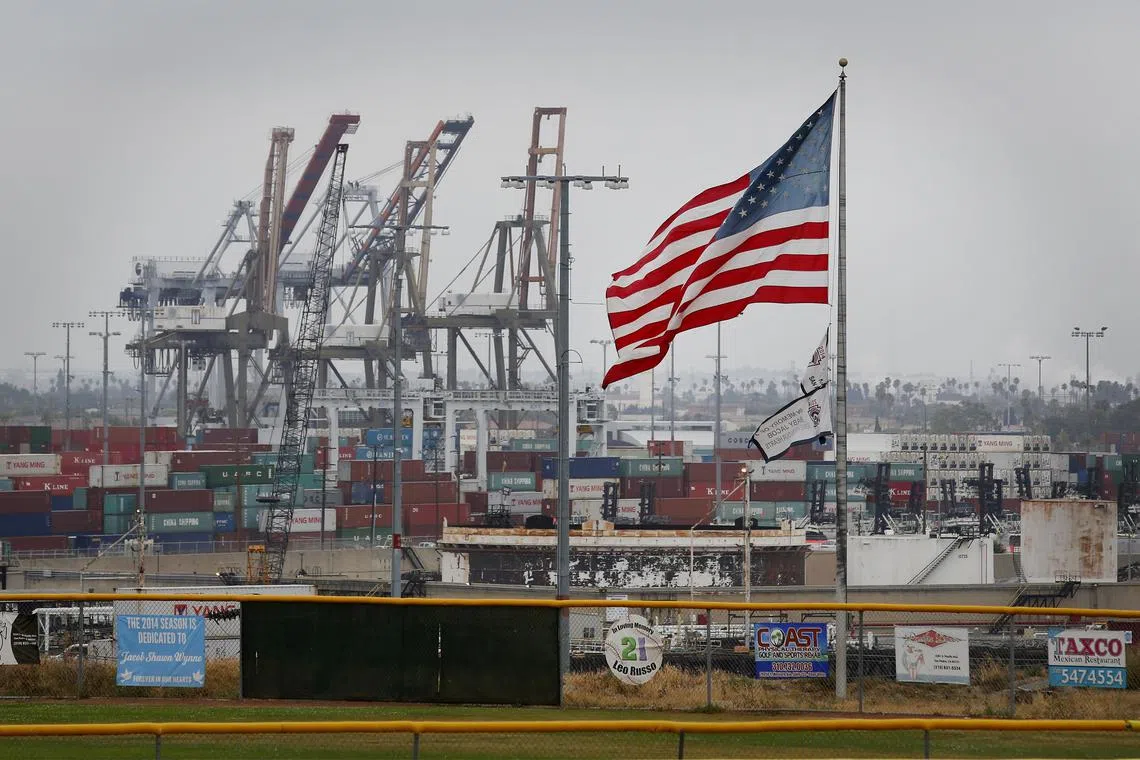Busiest US ports absorb import surge that is nearing pandemic-era frenzy
Sign up now: Get ST's newsletters delivered to your inbox

The ports of Los Angeles (above) and Long Beach, which account for roughly a third of all US container imports, had their third-strongest month ever in July.
PHOTO: BLOOMBERG
Follow topic:
Los Angeles - The busiest port complex in the US is churning through import volumes near the highs set during the Covid-19 pandemic, despite worries about a cooling economy.
The ports of Los Angeles and Long Beach, which account for roughly a third of all US container imports, had their third-strongest month ever in July, just shy of an all-time high reached in May 2021. Back then, a wave of inbound consumer goods caused supply bottlenecks on land, and a queue of cargo ships waiting for a berth offshore was getting longer by the day.
Demand is now driven by retailers and other importers stocking up ahead of US tariffs on Chinese goods and a possible strike by a large group of American dock workers – adding to the usual frenzy of pre-holiday ordering that occurs during this time of the year.
The marine terminals in Southern California’s San Pedro Bay are withstanding the crush so far, though some gauges of capacity constraints are starting to rise.
“We’re in a strong position heading into the peak shipping season as consumers purchase back-to-school supplies and shippers move goods ahead of potential tariff increases,” said Port of Long Beach chief executive Mario Cordero in a statement. “We have plenty of capacity across our terminals, and cargo continues to move efficiently and sustainably.”
In the latest rush to restock, fear of delayed shipments is a big factor.
Talks between the union representing dockers on the East and Gulf coasts and their employers have reached an impasse, six weeks before their contract expires on Sept 30. So some ocean freight that might come through ports from Boston to Houston is shifting to West Coast gateways until that uncertainty is resolved.
According to data from Sea-Intelligence, a Copenhagen-based maritime data and advisory firm, every one day of a strike would take about five days for ports to clear the resulting cargo backlog. A one-week strike starting on Oct 1, for instance, would take until mid-November to work through.
Sea-Intelligence CEO Alan Murphy said in a research note released last week: “If we get a two-week strike, then realistically, the ports would not be back to normal operations until we are into 2025.”
Companies are also racing to beat the imposition of more tariffs on Chinese goods in the event that Donald Trump returns to the presidency in 2025 and fulfils a campaign pledge to step up the trade war with China and raise tariffs on all US imports.
According to data released in August by the National Retail Federation and Hackett Associates, US container imports through major ports in 2024 will reach 24.9 million measured in 20-foot equivalent units, up 12 per cent from 2023, and close to 2021 and 2022 levels that topped 25 million.
LA-Long Beach and other West Coast ports have been losing market share to their eastern rivals for years. Hackett Associates founder Ben Hackett said fresh worries about labour disruptions at eastern ports have pushed the West Coast’s share of cargo “above 50 per cent for the first time in over three years”.
Such factors are distorting the demand picture, making it hard to know whether peak shipping season started early and trade volumes will level off soon, or if importers will continue bringing in more than usual.
There is also the chance that consumers’ ability to continue spending bottoms out, leaving warehouses full and companies with too much inventory.
The latest retail sales report reflects consumer resilience despite higher borrowing costs, a cooling labour market, and an economic outlook clouded by wars and the US presidential election in November.
But with pandemic savings now largely gone and wage growth cooling, many Americans are increasingly resorting to credit cards and other loans to support their purchases. BLOOMBERG

